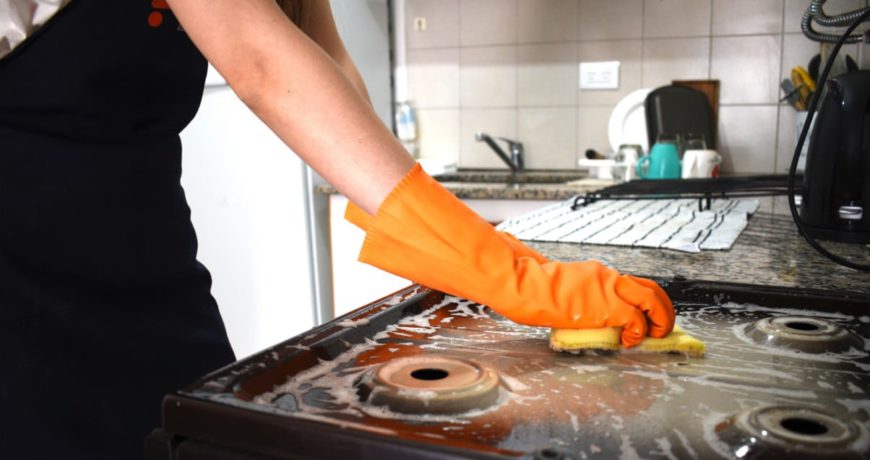
- by
- Hospitality
What is Kitchen Degreaser And How to Use Them
What are degreasers? Kitchen degreasers, or degreasing cleaners as they’re sometimes called, are used to remove fats and oils from surfaces. Whether that be dirty dishes or even cooking tools like pans and pots.
It’s common for degreasers to come in both spray form and as a soap-like liquid (not dissimilar to dish soap).
To use degreasers on dirty surfaces, simply spray or pour the degreaser over the surface and allow it to soak in for up to 15 minutes before scrubbing with a sponge/brush/soap scourer. For heavily soiled areas such as ovens, leave the degreaser on overnight before wiping away any residue the following day.
This article will provide you with sufficient information on kitchen degreasers and how to use them.
All You Need to Know About Kitchen Degreasers
Kitchen degreasers are becoming more popular in recent years due to the increasing awareness of household wastes and pollution. This is especially true for degreasers because they help make the cleaning process easier without toxic chemicals.
Kitchen degreasers can cut through grease, oil, dirt, and grime with ease typically while leaving behind a fresh scent.
For degreasing all-purpose greases like fats or oils, use a degreaser that is safe to be used on skin contact since this degreaser should be mostly for hand and body degreasing like soap.
- The best degreaser will be one that has various applications (for example grease on cookware or grease in your oven) while also being environmentally friendly.
- One of the most important things to consider when choosing a degreaser is how it will affect our planet and people’s health.
- It’s important to buy degreasers that are environmentally friendly, non-toxic, and made with only natural ingredients (with minimal chemical additives). Such initiatives will help you in the long run, as well.
Since degreasers work by cutting through oil (on the skin) and breaking it apart, you’ll want to make sure not to stay in one section too long especially if your degreaser has strong chemicals.
It’s important never to ingest any degreasers even if they are natural or organic so drink lots of water after using them.
Kitchen Degreasers And You
The best degreaser for this purpose should not contain perfume or other strong fragrances (like deodorants) since manufacturers add these such substances to mask the use of harsh chemicals in their degreasing agents.
When cleaning your kitchen, degreasing larger surfaces like large pots and pans you’ll want an industrial degreaser that works quickly and efficiently without damaging your cookware.
For degreasing smaller surfaces like countertops, sinks, and stove-tops you can choose a degreaser that fits into your budget or is easily accessible for you.
How to Degrease without Damage to Your Surfaces
When degreasing, make sure to avoid using degreasers with high chemical additives since it might result in damage done to your kitchen surfaces (such as rubber gloves).
It’s always best to degrease in sections so the degreasing agent doesn’t sit too long on one surface without being washed off.
Caution: You’ll want to wear protective gloves when degreasing just in case of accidental splashing or incidental direct contact with the degreasing agent since it may cause irritation. Make sure not to ingest degreasing agents by accident since they are not meant to be ingested or swallowed.
You’ll also want to degrease in a well-ventilated area so you don’t inhale any of the degreaser’s harmful fumes which can cause dizziness, nausea, and other side effects.
It’s best to degrease outside or in an open space where there is plenty of ventilation with fans.
Types of Kitchen Degreasers
There are three main types of degreasers typically used in the household kitchen.
– Dish soaps
– Acidic degreaser (typically lemon juice or vinegar)
-Chemical Degreasers
- Dish Soap degreasers
Dish soap degreasers work by lifting grease off the surface to clean while also adding moisture which usually leaves behind a fresh scent.
The best degreaser dish soap should be able to quickly lift grease off surfaces while also being environmentally friendly and safe for people (especially children) to use without irritation or other side effects.
It’s important to make sure that the degreasing dish soap is not overly harsh which can strip away protective oils on your skin making them prone to dryness.
- Acidic degreasers
Acidic degreasers work through their acidic content which helps dissolve grease to lift it off surfaces.
The best degreaser will be one that is strong enough to cut through tough grease without the risk of damage done to your cookware or other cleanable items caused by acid erosion.
- Chemical degreaser
Chemical degreasers are degreasers that work through the use of chemical agents like chlorine bleach and ammonia (which may cause irritation or even harm to people).
These can be effective for cleaning tough, baked-on grime but require caution when using them. It’s important to check safety precautions before using any type of degreaser, especially ones that use harsh chemicals since it can be dangerous if mishandled.
Here are some things to consider when purchasing a degreaser:
- The smell of the degreaser should not linger after use
- A degreaser should be able to dissolve fats than normal soaps do. This degreaser will be more efficient and last longer.
- The degreaser should not damage surfaces or leave a film behind in the kitchen.
- A degreaser is a great way to cut through grease in your home, but only if you use it properly. Make sure to apply at night so that degreaser can sit overnight before wiping away with a clean cloth followed by water for best results.
It’s important never to mix acidic degreasers with dish soap degreasers since it may create dangerous chemical reactions that could cause irritation/harm to the skin.
To degrease effectively, scrub off as much dried grease as possible before adding degreasing agent then wait for about 30 minutes for it to clean before washing off.
Closing Remarks
We hope this article regarding kitchen degreasers has been useful to you. If you have any queries, do not hesitate to contact us!

